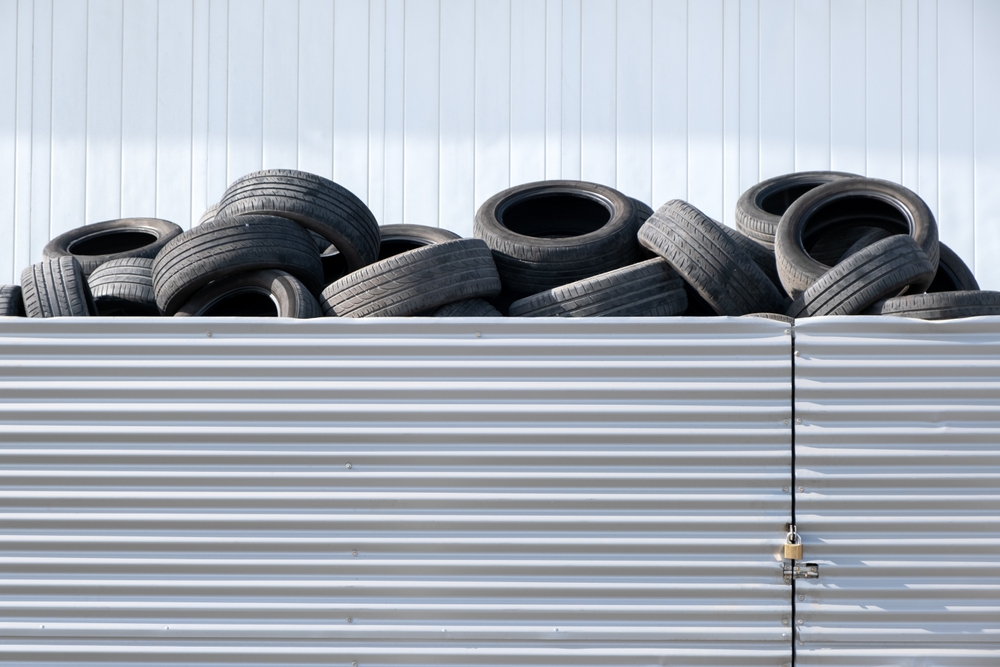Company Repurposes Discarded Tires To Create Durable Noise Reduction Barriers Aiming To Prevent 300 Million Tires From Landfills

What happens to the billions of tires that wear out each year? Unlike a plastic bottle or a cardboard box, an old tire doesn’t simply vanish into a recycling bin. It lingers—stacked in landfills, polluting waterways, or burned, releasing toxic chemicals into the air. The world churns out an estimated 300 million discarded tires annually, yet finding sustainable ways to repurpose them remains a daunting challenge.
Now, a Czech company, mmcité+, has found an innovative way to give old tires a second life—by transforming them into noise-reducing barriers for highways and railways. These barriers, aptly named “Noba,” not only help minimize urban noise pollution but also prevent massive amounts of rubber waste from clogging the environment. Even more impressively, local communities play a role in their design, ensuring they blend seamlessly into public spaces rather than becoming another eyesore.
Why Old Tires Are One of the World’s Biggest Environmental Nightmares
 Image Source: Shutterstock
Image Source: Shutterstock
Every year, millions of tires reach the end of their lifespan, yet they don’t simply disappear. Unlike organic waste that decomposes naturally, tires are designed for durability, making them notoriously difficult to break down. As a result, they accumulate in landfills, taking up massive amounts of space and posing environmental hazards. Tires in landfills trap methane gas, increasing the risk of fires that are nearly impossible to extinguish. Meanwhile, abandoned tires in open spaces collect rainwater, creating the perfect breeding ground for disease-carrying mosquitoes and other pests.
Beyond landfills, improperly discarded tires contribute to pollution in more insidious ways. When left exposed to the elements, they break down into microplastics and leach harmful chemicals into the soil and waterways, contaminating the very ecosystems that sustain life. Efforts to manage tire waste through incineration have also proven problematic. Burning tires releases toxic pollutants like carbon monoxide, sulfur dioxide, and heavy metals, which not only degrade air quality but also contribute to respiratory illnesses and environmental degradation.
Recognizing these growing concerns, the European Union took decisive action in 2003, banning tires from landfills and pushing industries to develop sustainable alternatives. This policy shift led to increased recycling efforts, with old tires being repurposed into playground surfaces, artificial turf, and even rubberized asphalt for roads. However, these initiatives still only scratch the surface of the problem. The sheer volume of discarded tires remains overwhelming, underscoring the need for more large-scale, innovative solutions to keep them out of waste streams and put them to better use.
This is where projects like mmcité+’s noise barriers present a game-changing approach. By transforming discarded tires into functional, long-lasting infrastructure, they tackle two major modern challenges at once—waste reduction and urban noise pollution.
What Makes “Noba” a Game-Changer?
Pardubice enjoys brand new noise barrier wall @mmcite_plus . Thank you for letting us do it! pic.twitter.com/0GcJQSRK4S
— mmcité+ (@mmcite_plus) March 21, 2018
In the search for sustainable solutions, repurposing waste into functional infrastructure is one of the most impactful ways to reduce environmental harm. This is exactly what the Czech company mmcité+ has achieved with its innovative noise barriers, known as Noba. Made from recycled tires, these barriers are designed to absorb and reduce noise pollution along highways and railways while simultaneously keeping millions of discarded tires out of landfills. Unlike traditional concrete or metal sound barriers, Noba not only offers environmental benefits but also enhances urban aesthetics and community well-being.
What sets Noba apart is its ability to combine durability, efficiency, and sustainability. Tires are made from high-strength rubber compounds designed to withstand extreme wear and tear, making them an ideal material for long-lasting infrastructure. By leveraging this durability, mmcité+ has created noise barriers that can endure harsh weather conditions, resist corrosion, and maintain their effectiveness for years without requiring frequent replacement. This extended lifespan further reduces waste and the need for additional raw materials, contributing to a circular economy where products are reused rather than discarded.
Beyond their longevity, Noba barriers excel in their primary function—noise reduction. The porous rubber structure of recycled tires absorbs and dampens sound waves more effectively than conventional materials, creating a quieter environment for nearby communities. Noise pollution, often overlooked in discussions about environmental health, has been linked to increased stress, sleep disturbances, and even cardiovascular issues. By mitigating excessive noise levels, these barriers not only improve quality of life but also support public health in urban areas.
Another key advantage of Noba is its versatility and aesthetic adaptability. Unlike traditional noise barriers, which are often seen as dull, industrial eyesores, these barriers can be customized to blend into their surroundings. Local communities are even given the opportunity to contribute to their design, ensuring that they complement the landscape rather than disrupt it. This level of public engagement fosters a sense of ownership and pride while reinforcing the idea that sustainability can be seamlessly integrated into everyday spaces.
Why Sustainability Works Best With Community Involvement
We are finishing the #Třinec – Nebory noise barrier project. #nobadigi #mmciteplus pic.twitter.com/fYbSY13FRo
— mmcité+ (@mmcite_plus) October 20, 2017
Sustainability isn’t just about repurposing materials—it’s also about creating solutions that serve the people who interact with them. What makes mmcité+’s Noba barriers stand out is not just their eco-friendly design but the way they actively involve local communities in the process. Unlike traditional infrastructure projects that often impose changes on neighborhoods without input from residents, this initiative recognizes the importance of collaboration, allowing the people who live near these noise barriers to help shape their appearance.
This approach transforms the barriers from a simple noise-reduction measure into a community-driven design project. Residents are given the opportunity to contribute to the visual aspects of the barriers, ensuring they blend harmoniously with the local environment rather than becoming an industrial eyesore. This participatory model fosters a sense of ownership, making people feel more connected to the improvements in their surroundings rather than viewing them as imposed changes.
Beyond aesthetics, this kind of engagement has deeper social implications. Studies have shown that when people are involved in the planning and design of their public spaces, they feel more invested in their communities, leading to increased civic pride and a stronger sense of belonging. This initiative also helps shift the perception of waste from being a burden to a resource that can be transformed into something beneficial for society.
Moreover, noise pollution is more than just an annoyance—it has measurable effects on health and well-being. Chronic exposure to high noise levels has been linked to increased stress, anxiety, sleep disturbances, and even cardiovascular issues. By reducing noise in residential areas and near public spaces, these barriers help create a more peaceful, livable environment. The fact that the very people affected by noise pollution get to influence the solution makes the project even more meaningful.
A Blueprint for a Greener Future
The #Třinec ring road opened, around which we built 67 noise-reducing barriers over a total distance of 18 kilometers. More on blog: https://t.co/qEmJBd3BYs #mmciteplus pic.twitter.com/ZwT1Op6Ddz
— mmcité+ (@mmcite_plus) November 16, 2017
The Noba project is more than just an innovative use of discarded tires—it represents a shift toward a circular economy, where waste materials are continuously repurposed rather than discarded. In a world where industries are under increasing pressure to reduce their environmental impact, solutions like these demonstrate how sustainability and functionality can coexist. Instead of viewing old tires as useless waste, mmcité+ has redefined them as a valuable resource for infrastructure, setting an example for other industries to follow. This approach aligns with a growing global movement to rethink waste management and sustainable urban planning. Many industries are now looking beyond traditional recycling methods and embracing upcycling—turning waste into high-value products that serve a new purpose.
From repurposing ocean plastics into durable furniture to using construction debris in road paving, companies are beginning to realize that sustainability is not just about reducing harm but about creating innovative, long-term solutions. The potential for scaling projects like Noba is enormous. While the current focus is on noise barriers for highways and railways, similar technology could be applied to other areas, such as building insulation, public seating, or even flood-resistant infrastructure. By demonstrating that recycled materials can meet both functional and aesthetic needs, mmcité+ is paving the way for broader adoption of waste-based construction materials.
On a policy level, initiatives like this also highlight the importance of government support and regulatory frameworks that encourage sustainable innovation. The European Union’s landfill ban on tires was a crucial step in driving companies toward alternative solutions, proving that effective legislation can stimulate environmental progress. If other regions implement similar policies, it could accelerate the adoption of waste-to-resource projects on a global scale.
Ultimately, the success of Noba serves as a reminder that sustainability is not about sacrifice—it’s about rethinking how we use resources and designing solutions that benefit both people and the planet. As industries, governments, and communities continue to collaborate on waste reduction strategies, projects like this offer a blueprint for a future where nothing is wasted, and everything has a purpose.
How Waste-Based Innovation Is Reshaping Our Cities
The Noba noise barriers by mmcité+ are a testament to how innovation and sustainability can go hand in hand. By transforming discarded tires into functional, aesthetically pleasing infrastructure, this project tackles two major urban challenges at once—waste management and noise pollution. Rather than allowing millions of tires to pile up in landfills or pollute ecosystems, mmcité+ has found a way to redefine waste as a resource, proving that sustainable solutions don’t have to come at the expense of functionality or design.
Beyond its environmental benefits, the Noba initiative also highlights the power of community engagement in sustainable urban planning. By involving local residents in the design process, these noise barriers become more than just infrastructure—they become an extension of the communities they serve. This approach fosters a sense of ownership, demonstrating that sustainability is not just about what materials we use, but also how we integrate them into the spaces we live in.
Projects like Noba set an important precedent for other industries looking to repurpose waste into practical, long-lasting solutions. Whether it’s using recycled materials in construction, turning ocean plastic into durable goods, or finding new ways to create a circular economy, this initiative proves that rethinking waste is one of the most impactful ways to build a more sustainable future.
Featured Image Source: Shutterstock
Loading...
Related Content
 When Science Shows Our Bones Can Rise Again
When Science Shows Our Bones Can Rise AgainBy Prince Ea





